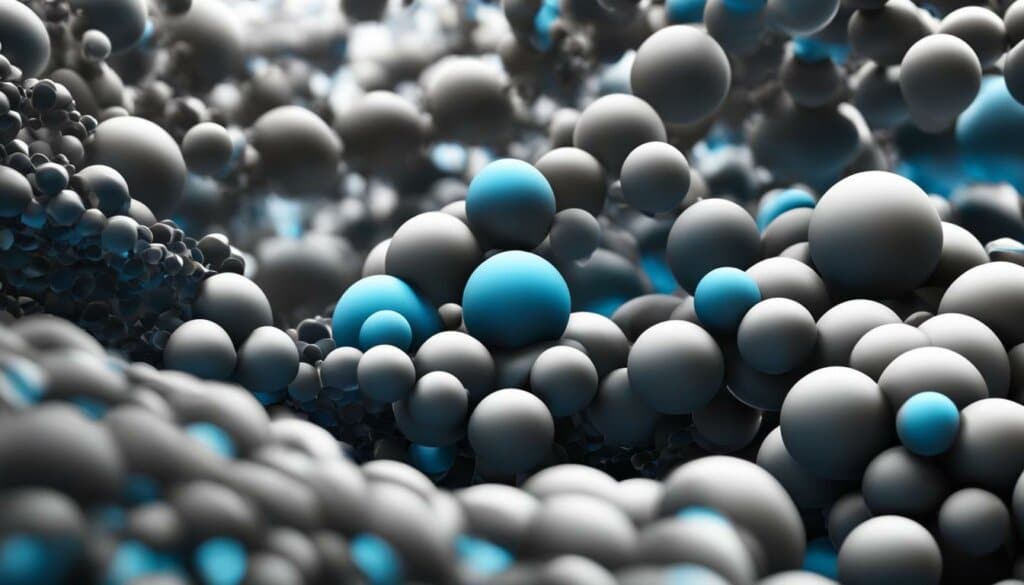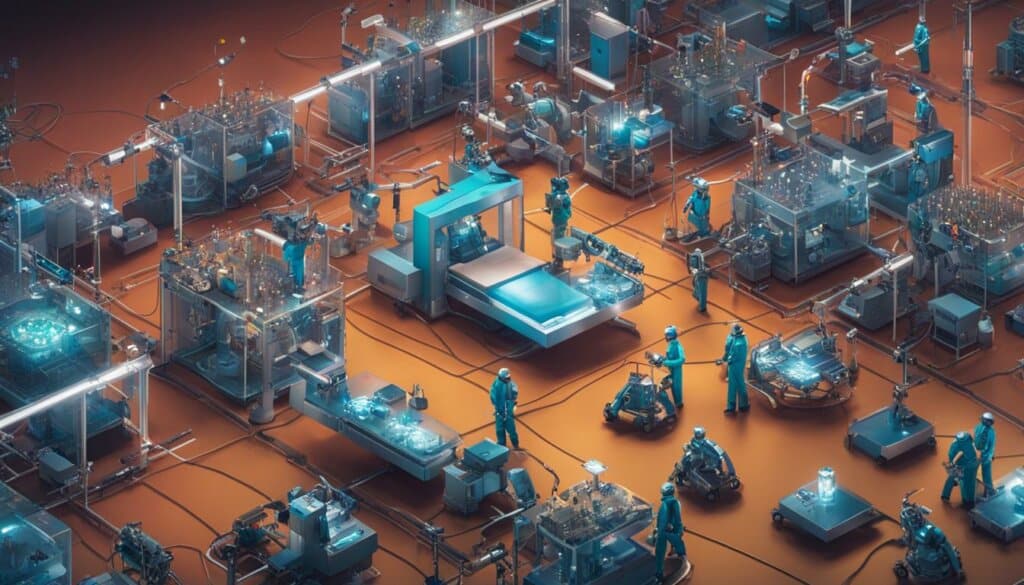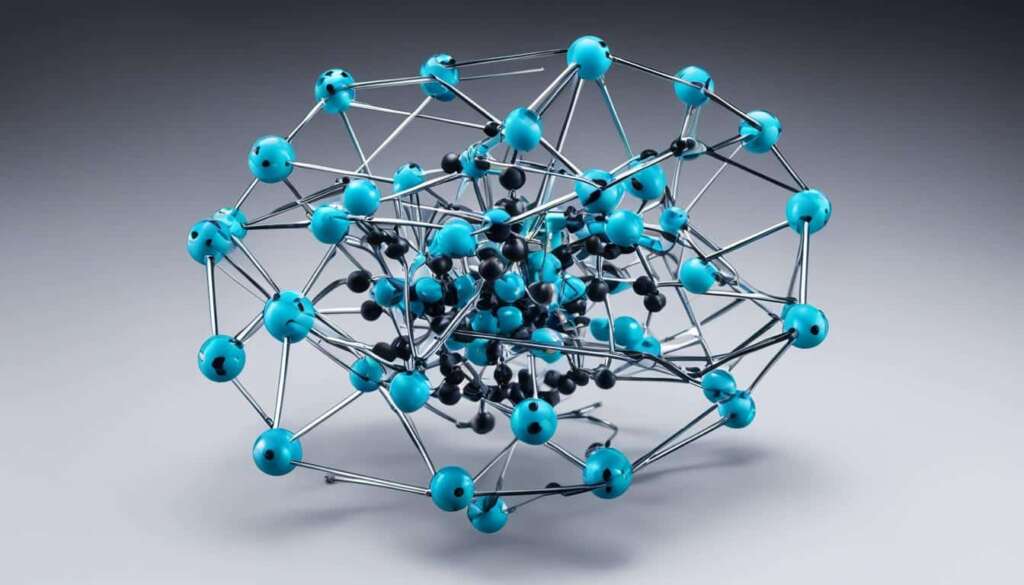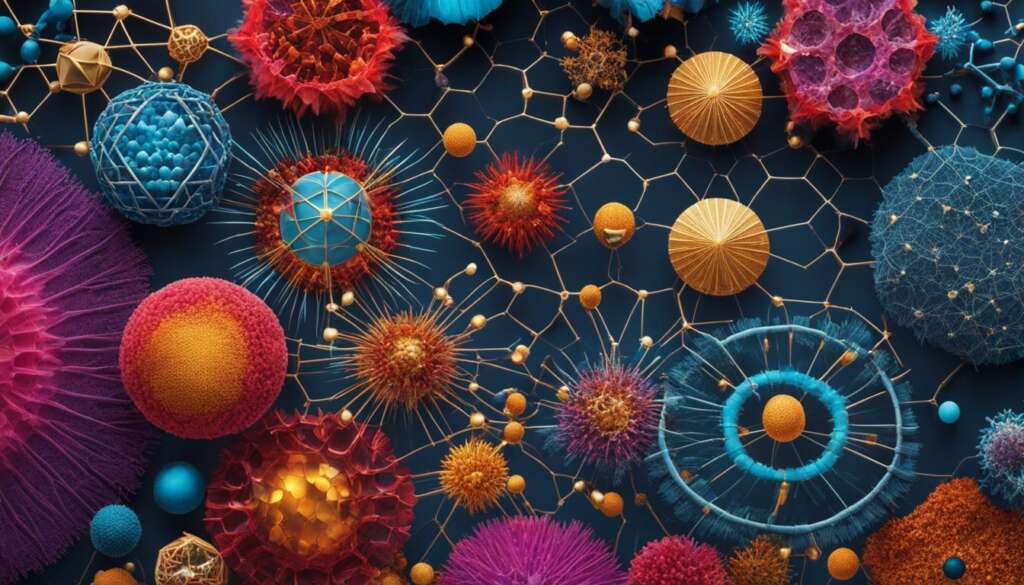Table of Contents
Nanotechnology is not a futuristic concept; it is already being used in various industries. Nanomaterials and nanoproducts are being used in textiles, cosmetics, paints, adhesives, plastics, sports equipment, automobiles, pharmaceutical products, electronics, glass industry, and more. Nanotechnology has practical applications in our everyday lives and continues to advance with new discoveries and innovations.
Key Takeaways:
- Nanotechnology is already integrated into various industries and products.
- Nanomaterials and nanoproducts are used in textiles, cosmetics, electronics, and more.
- Advancements and innovations in nanotechnology are ongoing.
- Nanotechnology has practical applications in our everyday lives.
- It is a rapidly advancing field with promising potential.
Dispelling the Myths About Nanotechnology
There are several myths surrounding nanotechnology that hinder our understanding of its true potential. Let’s debunk these misconceptions and shed light on the reality of nanotechnology.
Myth 1: Nanotechnology will take decades to have any practical use.
Nanotechnology is not a futuristic concept; it is already being utilized in a wide range of products. Nanomaterials and nanoproducts have practical applications in textiles, cosmetics, paints, adhesives, plastics, and more. They are enhancing the performance of sports equipment, automobiles, pharmaceutical products, electronics, and even the glass industry. The myth that nanotechnology will only become practical in the distant future is simply not true. It is already integrated into our everyday lives, making our products more efficient, durable, and high-performing.
Myth 2: Nanotechnology can only be produced in tech-heavy regions like Silicon Valley.
Contrary to popular belief, nanotechnology is not exclusive to specific regions. Nanoproducts are fabricated in various countries around the world, including Australia, Poland, France, Egypt, Turkey, Spain, and Canada. Nanotechnology research and development centers have emerged globally, allowing scientists and engineers to explore its potential and contribute to advancements. The myth that nanotechnology is confined to a few tech-driven locations is unfounded. It is a field that flourishes through international collaboration and knowledge exchange.
It is essential to dispel these myths and educate ourselves about the current state of nanotechnology. By embracing its reality, we can fully appreciate the impact of nanotechnology in our lives and the countless possibilities it holds for the future.
Exploring the Properties of Nanomaterials
Nanomaterials possess fascinating properties when observed at the nanoscale dimension. As the size of particles changes, the arrangement of atoms varies, resulting in alterations in color. This phenomenon is known as the quantum size effect. For example, gold nanoparticles can appear red or blue depending on their size due to the interaction of light with the electrons at the nanoscale.
Furthermore, nanoscale materials exhibit enhanced surface areas compared to their larger-scale counterparts, leading to unique characteristics. These materials are stronger, more durable, and more conductive, making them highly desirable for numerous applications in various industries.
“The unique properties of nanomaterials at the nanoscale open up a world of possibilities in electronics, medicine, and environmental solutions.”
In the field of electronics, nanomaterials enable the development of smaller and more efficient devices, such as nanoscale transistors for integrated circuits. These materials also hold promise in medicine, with their potential use in targeted drug delivery systems and regenerative medicine. Additionally, nanomaterials contribute to environmental solutions by improving the efficiency of energy storage devices and enabling the development of lightweight, sustainable materials.
Let’s take a closer look at the properties of nanomaterials compared to larger-scale materials in the following table:
| Nanomaterial Properties | Traditional Materials Properties |
|---|---|
| Increased surface area | Limited surface area |
| Enhanced strength and durability | Reduced strength and durability |
| Improved conductivity | Lower conductivity |
These distinct properties of nanomaterials make them invaluable in the development of advanced technologies and innovative solutions. By harnessing the unique characteristics exhibited at the nanoscale, researchers and engineers can push the boundaries of what is possible in various fields.

Classification of Nanomaterials
Nanomaterials play a significant role in various industries, offering unique properties and potential applications. They can be classified into two broad categories: natural nanomaterials and artificial nanomaterials. Understanding their classification is essential in harnessing their full potential.
Natural Nanomaterials:
Natural nanomaterials are found in the environment and occur naturally. They can be sourced from various places, such as volcanic ash or even certain molecules found in our bodies. These nanomaterials have unique properties due to their nanoscale dimensions, making them valuable in different fields of study.
Artificial Nanomaterials:
Artificial nanomaterials, on the other hand, are purposely created by human intervention. These nanomaterials are specifically designed for various applications and can be manipulated to possess specific properties. The controlled fabrication of artificial nanomaterials has paved the way for significant advancements in areas such as electronics, medicine, and manufacturing.
Here are some examples of artificial nanomaterials:
- Nanotubes: These cylindrical structures exhibit remarkable strength and unique electrical properties. They have applications in nanoelectronics, energy storage, and composite materials.
- Buckyballs: Also known as fullerenes, buckyballs are hollow carbon molecules that resemble soccer balls. They have exceptional strength and are used in areas such as drug delivery and catalysts.
- Nanoparticles: Tiny particles with sizes ranging from 1 to 100 nanometers, nanoparticles possess diverse properties based on their composition. They find applications in biomedical imaging, sensors, and environmental remediation.
- Dendrimers: Highly branched molecules with symmetrical structures, dendrimers have controllable surface functionalities and precise size distribution. They are utilized in drug delivery systems and gene therapy.
These artificial nanomaterials demonstrate the wide range of possibilities and potential applications within nanotechnology.
Nanomaterials, whether natural or artificial, hold immense promise for advancements in various industries. Their unique properties at the nanoscale make them invaluable for developing innovative solutions in electronics, medicine, and manufacturing.
Nanoscience and Nanotechnology
Nanoscience and nanotechnology are interconnected fields that delve into the study and manipulation of matter at the nanometer-scale, which is approximately one to 100 nanometers in size. Nanoscience focuses on understanding the fundamental properties and behavior of materials at this scale, while nanotechnology harnesses this knowledge to design and create functional nanoscale structures, devices, and systems.
Nanotechnology utilizes the unique physical, chemical, mechanical, and optical properties of materials that occur at the nanoscale. At this scale, the behavior and characteristics of materials can drastically differ from their bulk counterparts, opening up new possibilities for innovation and application.
By harnessing the power of nanotechnology, scientists and engineers can develop advanced materials, create more efficient and precise manufacturing processes, and design cutting-edge devices and technologies. Nanotechnology is a multidisciplinary field that draws from various scientific disciplines, including biology, chemistry, physics, materials science, and engineering. This interdisciplinary nature allows experts from different backgrounds to collaborate and combine their expertise to push the boundaries of what is possible.
Nanotechnology has the potential to revolutionize multiple sectors, including healthcare, energy, electronics, telecommunications, and more. In healthcare, nanotechnology enables targeted drug delivery systems, precise diagnostics, and regenerative medicine approaches. In energy, nanotechnology can improve the efficiency of solar cells, develop lightweight and high-capacity energy storage devices, and enhance energy generation from renewable sources. In electronics and telecommunications, nanotechnology plays a crucial role in developing faster and smaller electronic components, improving displays, and enabling high-speed communication networks.
Key takeaway: Nanoscience explores the fundamental properties of materials at the nanometer-scale, while nanotechnology applies this knowledge to design and create functional nanoscale structures and systems. Nanotechnology is a multidisciplinary field with the potential to revolutionize healthcare, energy, electronics, and telecommunications.
Current Applications of Nanotechnology
The applications of nanotechnology are already transforming various industries and everyday life. Here are a few examples of how nanotechnology is being utilized:
- In medicine, nanotechnology enables targeted drug delivery systems, imaging techniques, and tissue engineering approaches.
- In electronics, nanotechnology allows for the fabrication of smaller and more efficient components, enabling faster processors, high-resolution displays, and improved memory storage.
- In environmental solutions, nanotechnology plays a role in developing efficient catalysts for pollution control, water purification systems, and sustainable energy generation.
- In materials science, nanotechnology is used to create stronger and lighter materials, such as carbon nanotubes and graphene, with applications in aerospace, automotive, and construction industries.
- In consumer products, nanotechnology is employed in cosmetics, sunscreens, clothing, and even food packaging to enhance product performance and safety.
The Future of Nanotechnology
The field of nanotechnology continues to advance rapidly, driven by ongoing research, collaborations, and innovations. As scientists and engineers gain a deeper understanding of nanoscale phenomena, they can develop even more sophisticated nanomaterials, nanodevices, and nanosystems with tailored properties and functions.
The future of nanotechnology holds exciting possibilities. Researchers are exploring novel approaches to tackle global challenges, such as developing sustainable energy sources, improving healthcare outcomes, and addressing environmental issues. Nanotechnology has the potential to unlock new opportunities for advancements in fields like quantum computing, nanorobotics, and nanomedicine, where precise manipulation and control at the nanoscale are crucial.
It is important to monitor the progress of nanotechnology and its ethical, environmental, and safety implications. Responsible development and transparent communication of risks and benefits are vital to ensure a sustainable and beneficial future for nanotechnology.
Summary
Nanoscience and nanotechnology are dynamic fields that explore the properties and applications of matter at the nanoscale. Nanotechnology leverages the unique characteristics of nanomaterials to create innovative solutions in various industries, from healthcare to energy and electronics. With its multidisciplinary nature, nanotechnology brings together experts from different disciplines to drive advancements and shape the future of technology. The potential of nanotechnology is vast, and ongoing research and development will continue to pave the way for groundbreaking discoveries and applications.
Nanomanufacturing and Nanoelectronics
Nanomanufacturing plays a crucial role in the development of materials and technologies at the nanometer-scale. It involves two main approaches: top-down and bottom-up.
Top-down nanomanufacturing
Top-down nanomanufacturing involves carving bulk materials to create nanoscale features. This approach allows for precise control over the shape and size of the final product. One example of top-down nanomanufacturing is the fabrication of nanoelectronic devices using techniques like photolithography and etching. The top-down approach is widely used in the semiconductor industry to create smaller and more efficient electronic components.
Bottom-up nanomanufacturing
Bottom-up nanomanufacturing, on the other hand, builds products atom-by-atom or molecule-by-molecule. This approach leverages self-assembly processes and molecular synthesis to create nanostructures with specific properties. Bottom-up nanomanufacturing enables the production of complex nanostructures that cannot be achieved through top-down methods alone. One example of bottom-up nanomanufacturing is the synthesis of nanoparticles for applications in drug delivery, imaging, and sensing.
Nanoelectronics, a field closely related to nanomanufacturing, focuses on the development of electronic devices and components at significantly smaller size scales. As the size of traditional electronic components reaches its physical limits, nanoelectronics offers a promising avenue for further miniaturization and increased functionality.
Advancements in nanomanufacturing and nanoelectronics have paved the way for the development of new materials and technologies across various industries. From more efficient solar panels and flexible electronic displays to miniaturized biomedical devices, nanomanufacturing and nanoelectronics continue to drive innovation in nanotechnology.
| Advantages of Nanomanufacturing and Nanoelectronics | Applications |
|---|---|
| 1. Precise control over nanoscale features. | 1. Semiconductor industry |
| 2. Production of complex nanostructures. | 2. Drug delivery systems |
| 3. Further miniaturization of electronic components. | 3. Biomedical devices |
| 4. Increased functionality of electronic devices. | 4. Solar panels |
By harnessing the potential of nanomanufacturing and nanoelectronics, researchers and engineers can continue to push the boundaries of what is possible at the nanoscale. These advancements offer exciting opportunities for developing new materials, improving existing technologies, and addressing key challenges in various industries.

Applications of Nanotechnology in Everyday Life
Nanotechnology has rapidly expanded its presence in our daily lives, with a multitude of practical applications that improve various aspects of our everyday experiences. From mobile phones to medical devices, nanotechnology is already a part of numerous commercially available products.
Let’s take a closer look at some of the everyday uses of nanotechnology:
- Mobile Phones: Nanotechnology enables the production of smaller and more powerful electronic components, leading to the development of sleek and high-performing mobile phones.
- Computer Discs: Nanoscale structures are utilized in computer discs, increasing their storage capacity and allowing for faster data transfer rates.
- Textiles: Nanocoatings applied to textiles make them resistant to stains, water, and wrinkles, enhancing durability and comfort.
- Cosmetics: Nanoparticles are incorporated into cosmetics to provide better coverage, UV protection, and improved delivery of active ingredients.
- Sunscreen: Nanotechnology plays a crucial role in the development of sunscreens that offer transparent and effective protection against harmful UV rays.
- Medical Devices: Nanoscale materials are used in medical devices such as implants and prosthetics, improving biocompatibility and enhancing their performance.
- Chemical Coatings: Nanocoatings are applied to various surfaces to provide protection against corrosion, scratches, and wear, extending the lifespan of products.
- Security Systems: Nanotechnology is employed in the development of advanced security systems, including fingerprint sensors and nanoscale authentication technologies.
- Water Purification Units: Nanofilters enable the efficient removal of contaminants and pollutants from water, making it safer for consumption.
- Displays and Cinema Screens: Nanoscale light-emitting diodes (LEDs) and quantum dots are used in displays and cinema screens, offering vivid colors, high resolution, and energy efficiency.
These are just a few examples of how nanotechnology has found its way into our everyday lives. Its diverse applications continue to pave the way for innovation and improvements in various industries.
Nanotechnology Applications in Everyday Life
| Product/Industry | Application of Nanotechnology |
|---|---|
| Mobile Phones | Smaller and more powerful electronic components |
| Computer Discs | Increased storage capacity and faster data transfer rates |
| Textiles | Stain, water, and wrinkle resistance |
| Cosmetics | Better coverage, UV protection, and improved ingredient delivery |
| Sunscreen | Transparent and effective protection against UV rays |
| Medical Devices | Improved biocompatibility and performance |
| Chemical Coatings | Protection against corrosion, scratches, and wear |
| Security Systems | Advanced authentication technologies |
| Water Purification Units | Efficient removal of contaminants and pollutants |
| Displays and Cinema Screens | Vivid colors, high resolution, and energy efficiency |
As nanotechnology continues to advance, we can expect even more innovative applications in various fields, improving our lives and pushing the boundaries of what is possible.
Nanobiotechnology and Nanomedicine
Nanobiotechnology is an exciting field that combines the precision of nano-scale engineering with the complexity of biology. Through this interdisciplinary approach, scientists are able to manipulate living systems and build biologically inspired materials at the molecular level.
One of the most promising applications of nanobiotechnology is in the field of nanomedicine. Nanotechnology is being utilized to develop innovative medical solutions, revolutionizing the way we diagnose and treat diseases.
Nanomedicine offers a wide range of applications, including targeted drug delivery, disease identification and treatment, and tissue engineering. By utilizing nanoscale materials, such as gold nanoparticles and dendrimers, researchers are able to take advantage of their unique properties and harness their potential to improve healthcare outcomes.
“Nanomedicine is a rapidly growing field that holds great promise for the future of healthcare. By leveraging nanotechnology, we are able to develop more targeted and effective therapies, improve diagnostics, and advance regenerative medicine.” – Dr. Sarah Johnson, Nanomedicine Researcher
The ability to precisely deliver drugs to specific cells or tissues holds tremendous potential for personalized medicine. Nanoparticles can be engineered to selectively target cancer cells, reducing the side effects associated with traditional chemotherapy treatments. This targeted approach not only improves treatment efficacy but also enhances patient comfort and quality of life.
Furthermore, nanomedicine enables early disease detection through the use of nano-sized biosensors. These biosensors can detect disease markers in the body, allowing for early intervention and better patient outcomes. Additionally, nanotechnology plays a crucial role in tissue engineering by providing scaffolds and growth factors that assist in the regeneration of damaged tissues.

In conclusion, nanobiotechnology and nanomedicine have the potential to revolutionize healthcare by offering targeted drug delivery, improved disease identification and treatment, and advancements in tissue engineering. With ongoing research and development, nanotechnology continues to pave the way for innovative solutions in the field of medicine.
Current Challenges and Future Outlook of Nanotechnology
Nanotechnology is a rapidly evolving field with immense potential for the future. However, it also faces various challenges that need to be addressed for responsible development and acceptance among the public.
Challenges of Nanotechnology
- Responsible Development: One of the main challenges is ensuring that nanotechnology is developed responsibly, considering the potential risks and ethical implications. This involves thorough research and assessment of the environmental and health impacts of nanomaterials and nanodevices.
- Public Concerns: Nanotechnology is a relatively new and complex concept for many people, leading to concerns about its safety, privacy, and potential misuse. It is important to address these concerns through transparent communication and regulations.
- Standardization: Establishing standardized protocols for the production, characterization, and testing of nanomaterials is essential to ensure quality control and proper evaluation of their properties and performance.
- Cost and Scalability: The cost of producing nanomaterials and nanodevices can be high, limiting their accessibility and scaling up production for widespread applications. Finding cost-effective manufacturing methods is crucial for the future advancement of nanotechnology.
Future Outlook of Nanotechnology
Despite the challenges, the future of nanotechnology holds great promise in several key areas:
- Renewable Energy: Nanotechnology has the potential to revolutionize the energy sector by improving energy efficiency, enabling lower-cost solar cells, and developing advanced energy storage solutions.
- Disease Treatment: Nanomedicine offers possibilities for targeted drug delivery, early disease detection, and personalized treatments. Nanoparticles can be designed to deliver drugs directly to specific cells or tissues, minimizing side effects and improving treatment efficacy.
- Advanced Telecommunications: The miniaturization of electronic components through nanotechnology allows for faster and more efficient communication systems. Nanoelectronics can lead to the development of smaller, more powerful devices with advanced functionalities.
Interdisciplinary collaboration among scientists, engineers, and researchers is crucial for further breakthroughs in nanotechnology. By addressing the challenges and continuing to push the boundaries of knowledge and innovation, nanotechnology can contribute to significant advancements in various fields, benefiting society as a whole.
| Challenges of Nanotechnology | Future Outlook of Nanotechnology |
|---|---|
| Responsible Development | Renewable Energy |
| Public Concerns | Disease Treatment |
| Standardization | Advanced Telecommunications |
| Cost and Scalability |
Explore Nanotechnology with AG CHEMI GROUP
If you’re looking for cutting-edge nanotechnology solutions, look no further than AG CHEMI GROUP. Based in Prague, AG CHEMI GROUP specializes in providing innovative nanotechnology solutions across various fields, including plastics, antiviral/antibacterial suspensions, pathogen destroying fabrics, and construction materials. With over 25 years of experience in supplying raw materials to manufacturers, AG CHEMI GROUP has established itself as a trusted partner in the industry.
AG CHEMI GROUP’s expertise extends to nanoparticles and patented nanotech processes, allowing them to deliver advanced solutions that cater to the ever-evolving needs of businesses. By investing in nanotechnology, AG CHEMI GROUP stays at the forefront of technological advancements and offers state-of-the-art products and services.
AG CHEMI GROUP not only provides nanotechnology solutions but also offers investment opportunities in this thriving industry. By partnering with AG CHEMI GROUP, investors can capitalize on the potential of nanotechnology and contribute to its growth and development.
AG CHEMI GROUP – Revolutionizing Industries with Nanotechnology Solutions.
| AG CHEMI GROUP | Nanotechnology Solutions | Investment Opportunities |
|---|---|---|
| Based in Prague | Plastics | Antiviral/Antibacterial Suspensions |
| Over 25 years of experience | Pathogen Destroying Fabrics | Construction Materials |
| Supplying raw materials | Nanoparticles | Patented Nanotech Processes |
Conclusion
Nanotechnology is a rapidly advancing field that is already integrated into our everyday lives, offering a wide range of applications with its unique properties. It is not just a futuristic concept but a reality that has the potential to revolutionize industries such as electronics, medicine, and manufacturing. With nanomaterials and nanoproducts being used in various products we use daily, nanotechnology is already making a significant impact.
While challenges exist, interdisciplinary collaboration and responsible development are key to unlocking the full potential of nanotechnology. By working together, scientists, engineers, and researchers can address concerns and ensure the safe and ethical use of nanotechnology. This will pave the way for future advancements, opening up new possibilities in renewable energy, disease treatment, advanced telecommunications, and more.
AG CHEMI GROUP is a prime example of a company actively contributing to the growth and innovation in nanotechnology. With their extensive experience and diverse range of nanotechnology solutions, they are driving advancements and providing investment opportunities in this field. As nanotechnology continues to evolve, companies like AG CHEMI GROUP play a vital role in shaping the future and harnessing the benefits of this transformative technology.
FAQ
Is nanotechnology a futuristic concept?
No, nanotechnology is not a futuristic concept. It is already being used in various industries and has practical applications in our everyday lives.
What are some common myths about nanotechnology?
One common myth is that nanotechnology will take decades to have any practical use. Another myth is that nanotechnology can only be produced in tech-heavy regions like Silicon Valley. In reality, nanomaterials and nanoproducts are already being used in a wide range of products and are fabricated in many countries.
What are the properties of nanomaterials?
Nanomaterials exhibit unique properties at the nanoscale dimension. They can have different colors, increased surface areas, and enhanced strength, durability, and conductivity compared to larger-scale materials.
How are nanomaterials classified?
Nanomaterials can be classified into natural nanomaterials, which occur naturally in the world, and artificial nanomaterials, which are intentionally produced by people.
What is the difference between nanoscience and nanotechnology?
Nanoscience is the study of matter at the nanometer-scale, while nanotechnology involves the understanding and control of matter at this scale. Nanotechnology utilizes the unique properties of materials that occur at the nanoscale.
What is nanomanufacturing and nanoelectronics?
Nanomanufacturing involves building materials on the nanometer-scale, either through top-down or bottom-up approaches. Nanoelectronics focuses on developing electronic devices and components at significantly smaller size scales.
Where is nanotechnology applied in everyday life?
Nanotechnology is applied commercially in products such as mobile phones, textiles, cosmetics, medical devices, displays, and water purification units.
What is nanobiotechnology and nanomedicine?
Nanobiotechnology combines nano-scale engineering with biology to manipulate living systems, while nanomedicine utilizes nanotechnology in medical applications such as targeted drug delivery and tissue engineering.
What are the current challenges and future outlook of nanotechnology?
Nanotechnology faces challenges in terms of responsible development and public concerns. However, its potential impact in fields like renewable energy, disease treatment, and telecommunications is vast. Interdisciplinary collaboration is crucial for further breakthroughs.
How does AG CHEMI GROUP contribute to nanotechnology?
AG CHEMI GROUP offers nanotechnology solutions in various fields, including plastics, antiviral/antibacterial suspensions, pathogen destroying fabrics, and construction materials. They have more than 25 years of experience supplying raw materials to manufacturers and provide advanced solutions in the industry.
What is the summary of nanotechnology?
Nanotechnology is a real and rapidly advancing field with a wide range of applications. It offers unique properties and potential to revolutionize industries such as electronics, medicine, and manufacturing.













